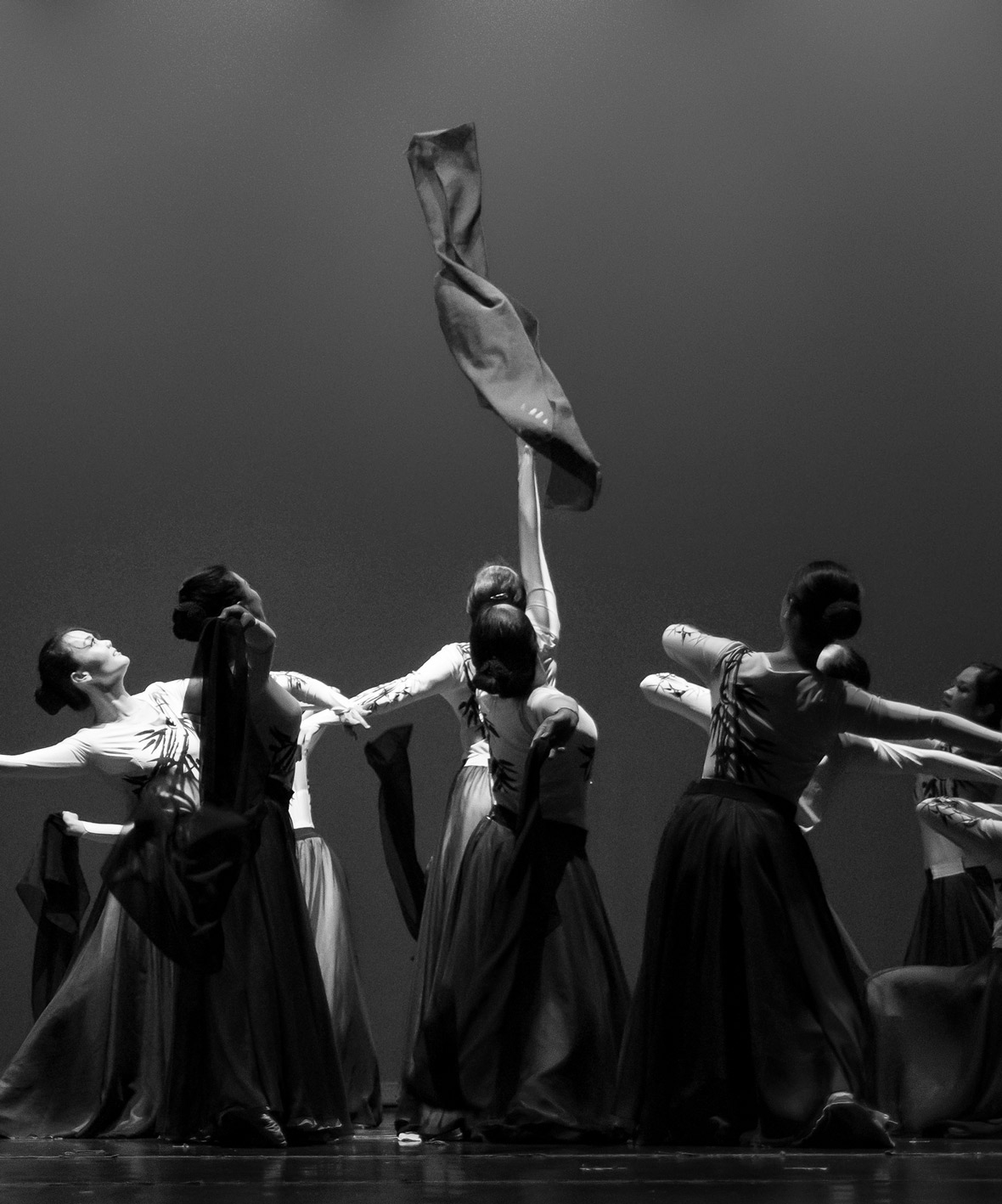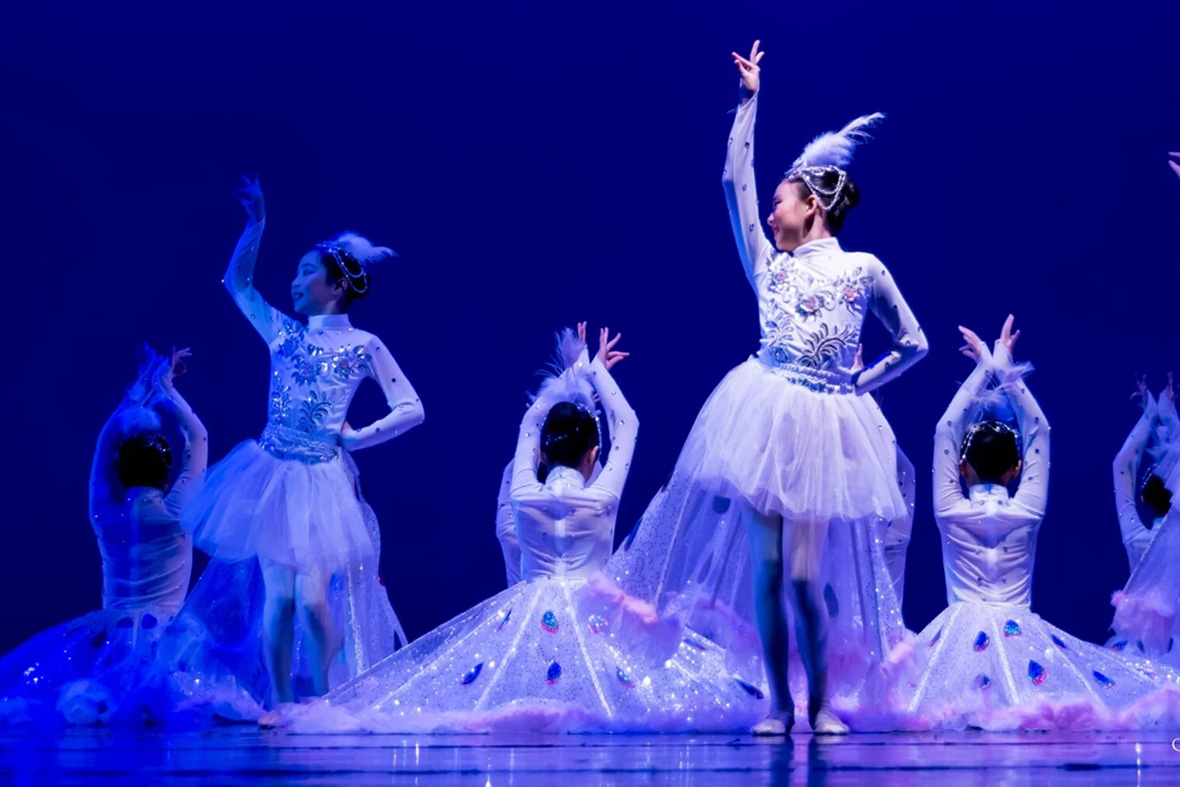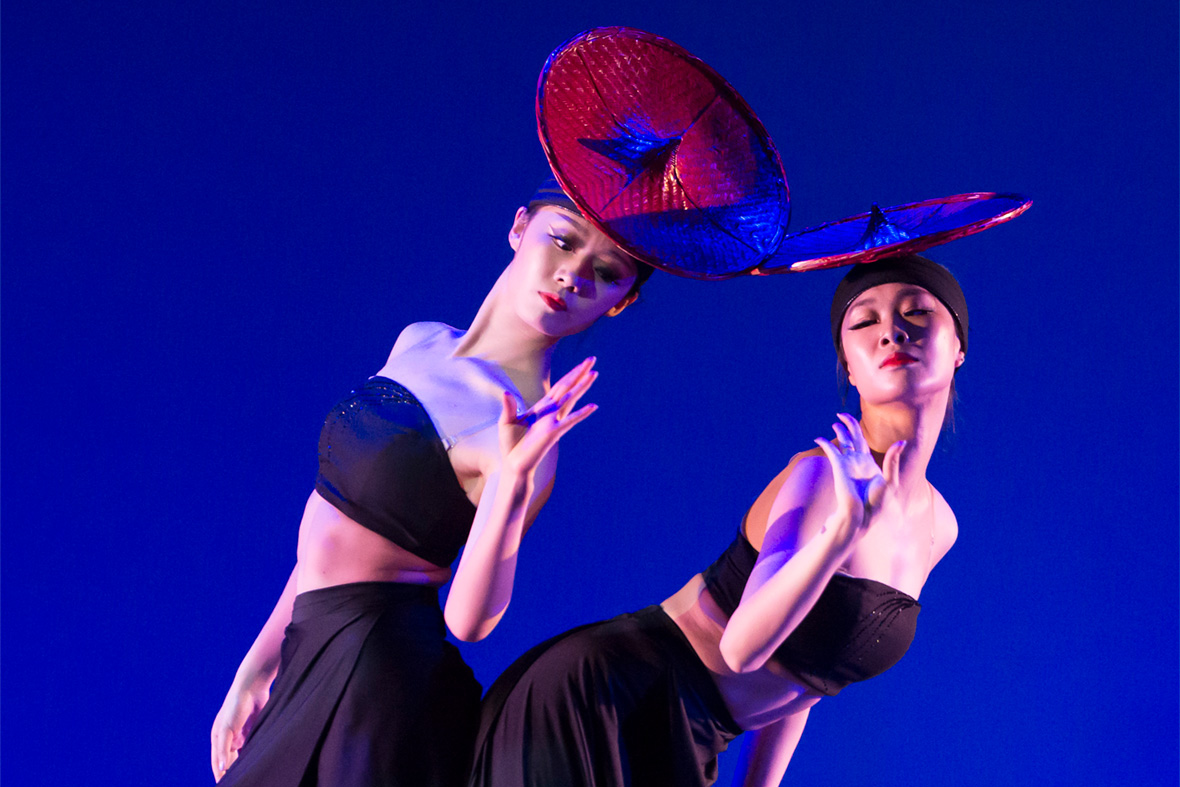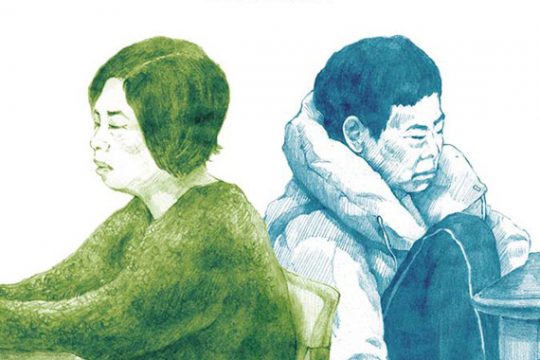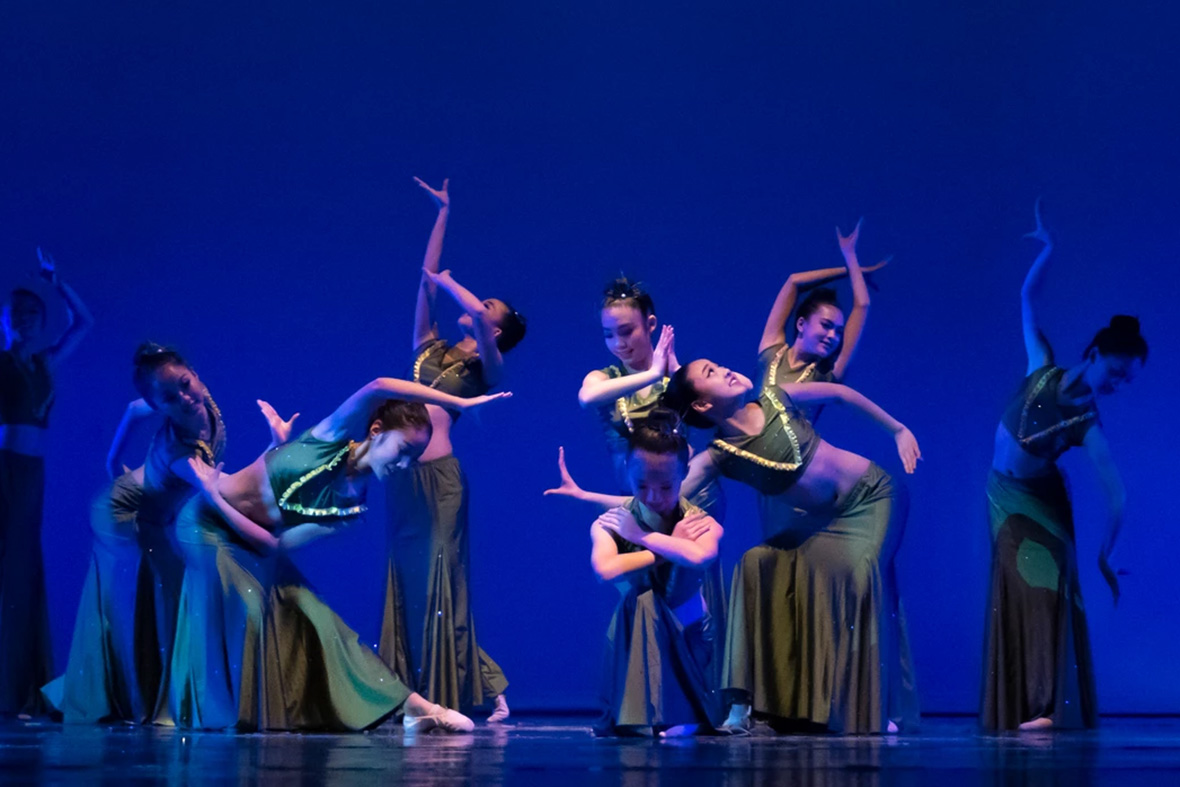
As classical Chinese court music fills the concert hall, the dancers on stage remain motionless, almost like specimens preserved in amber. Despite the stillness, their lithe figures exude an aura of grace. Within the melody, stringed instrumentations begin to blend into the composition, and an invisible force seems to set the 15 dancers in motion. They move with force and purpose, swinging their limbs. As they tiptoe along with the rhythm, their silk dresses seem free from the restraints of gravity. These dancers are fully in the moment, and nothing else seems to matter aside from the music and performance.
This impressive performance was choreographed by Artisan Dance Academy (ADA). As the first Chinese dance school in Boston, the organization teaches Chinese dance with a focus on cultural context and traditional sensibilities. The mission of the dance group is not about making students the next Martha Graham or Michael Jackson, but reviving one of the oldest Eastern art forms, Chinese dance, in America.
Established in 2016 in Needham, MA, ADA is dedicated to sharing the art of Chinese dance with students ranging from three to sixty years old. Through their explorations of classical Chinese dance, ethnic and folk dance, they look to bring new insight into Chinese heritage in a contemporary context.
The lead choreographer, Wang Meng, says that it hasn’t been an easy endeavor since classical Chinese dance is an art form that is little understood in the West.
“At first, we only had two students; they were practicing Chinese dance in their basement at the time,” she recalls. “And now we have around 400 students.”
音乐厅内回荡着中式古典的旋律;台上的舞者们一动不动,仿佛被定格成婀娜的琥珀。静籁之中,她们的身躯显得轻柔且优雅;一段弦乐响起,15 位舞者瞬间被无形的力量点燃,那舞步刚柔并济,细腻且张扬。她们身上的绸缎随音乐和舞步摆脱了重力,在空中划过数道美丽的线条。
舞者们全神贯注,浑然不知身外的世界。
她们来自 Artisan Dance Academy(ADA),是波士顿第一所中国舞学校,专注于中式舞蹈教学,以及舞蹈文化继承。团体的宗旨并不希望将学生培养成下一位玛莎·葛兰姆(Martha Graham)或迈克尔·杰克逊(Michael Jackson),而是在远洋彼岸,推广古老的东方艺术——中国舞。
ADA 于 2016 年马萨诸塞州尼德姆(Needham)建立,致力于向 3 到 60 岁的学生推广中国舞蹈艺术。他们尝试能通过探索中国古典、民族舞蹈,在异国他乡对中国传统文化进行更具有当代特色的诠释。
但事实上,ADA 的创始人之一王萌表示,从创办到运营整个学校并非容易的事。她回忆说:“我和搭档最初创建这所学校时只有两名学生,当时的排练室位于一处地下不大的空间。到现在,学校的师生人数已超过四百位。”
Traditional Chinese dance originated in the Zhou dynasty (c.1045-256 BCE) with yayue, music and dance performances that took place at the royal court. It’s an art form known for its diverse costumes, elaborate techniques, and stylized movements. Chinese dance can be divided into two broad categories: classical Chinese dance and folk dance. Classical Chinese dance is historically performed in the palace of the emperor, while folk dance reflects the unique cultures of China’s 56 ethnic minorities.
In the book Chinese Dance—In the Vast Land and Beyond, authors Shih-Ming Li Chang and Lynn E. Frederiksen point out that Chinese dance highlights a culture of sharing throughout its 5,000-year history. The authors proposed that “dance is the prism,” which legitimizes it as “a uniquely qualified resource for cross-cultural learning.” In this case, Chinese dance embodies a sharing of culture because it was created as a collective knowledge for the community “to educate, to entertain, to praise, and to unify.”
中国传统舞蹈起源于周朝(公元前 1045-256 年)的“雅乐”,即传统宫廷音乐,其背后蕴含的文化元素十分庞杂,囊括了种类繁多的演出服装、舞者们娴熟的技艺和专业考究的动作标准等等。当代普遍认为,中国舞蹈大致可分为两大类:中国古典舞和民族舞。不同的是,历史上中国古典舞是指在宫廷里进行的表演,而民族舞则是反映了中国 56 个民族的独特文化。
在《Chinese Dance: In the Vast Land and Beyond》一书中,作者 Shih- Ming Li Chang 和 Lynn E. Frederiksen 指出,在中华上下五千年的历史长河中,中国舞始终是一种关于分享的文化。他们提出了“舞蹈即棱镜”的观点,认为舞蹈可以映射中国各地的特色文化,是“推动跨文化交流的独特资源”。中国舞的诞生来源于华夏儿女的集体意识,为社会的“教育、娱乐、和谐和团结”起到了推动性作用,因而文化共享在中国舞身上得以体现。
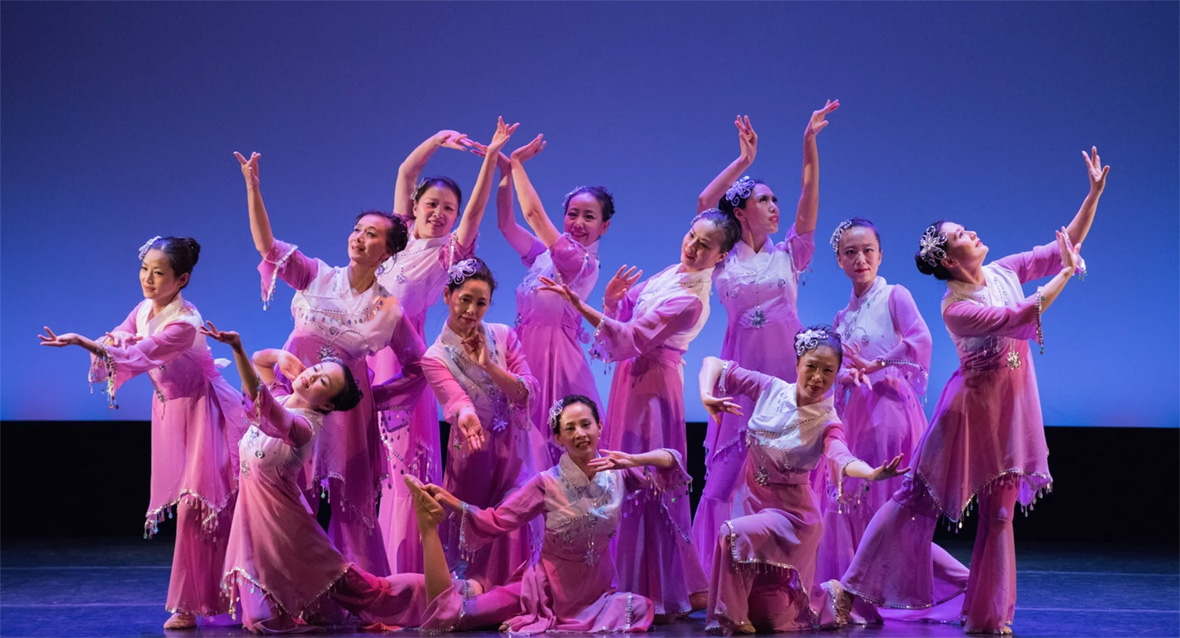
Wang believes that if Western audiences wish to better understand Chinese dance, they need to learn the country’s history.
“Unlike modern dance that arose out of America in the early 20th century, Chinese dance cannot survive without its rich cultural and historical backgrounds,” she says. “You can choreograph modern dance based on last night’s dream, but you cannot do it with Chinese dance. Chinese dance asks dancers to visualize the cultural lineage with your body.”
ADA not only leads students to appreciate the different types of dance in China but also provides them with important cultural knowledge.
In a class for younger kids, Wang asks everyone to perform a complicated kicking dance sequence. Some students hide behind their peers to avoid practicing the move. After seeing the hesitation, Wang turns off the music. Instead, she shares a history lesson. “Do you know where this kick comes from? It is a move borrowed from Hunan flower-drum opera.”
The anecdote seems to have worked. Some students try the move again; some crowd around Wang, tugging on her arm for more stories; and others laugh at their peers’ stiff moves.
Contemporary takes on Chinese dance is not solely about portrayals of the past or adaptations of classical literature; as Chinese dance has evolved, there’s now a certain universality to it.
“The themes of Chinese dance vary widely these days. Many Chinese dance performances visualize nature and express emotion,” says Wang.
The recently trending Chinese dance drama Soaring Wings (translated as “Crested Ibises” in Chinese), which was shown during the 2021 China Central Television Spring Festival Gala, had already been a big hit in America since its Boston debut in 2018.
With a perfect combination of classical ballet and traditional Chinese folk dance, the dance visualized the environmental concerns for endangered animals. In a 2018 interview with the Beijing Review, lead dancer Jiejing Zhu said that she believes that Chinese dance is an art form that can bridge the cultural divide between China and America. Through dance, language barriers aren’t an issue.
“Soaring Wings shows the interdependence between human beings and nature,” Zhu says. “People of different backgrounds and nationalities also need to peacefully coexist in this world. New York City is a city of cultural diversity. I hope the crested ibis, a bird symbolizing good fortune, can bring New Yorkers peace and friendship as well.”
Despite the success of Soaring Wings, the traditional Eastern art form has met some resistance in the West. Some experts argued that Chinese dance is serving the function of a “propaganda tool” in America.
In the book Revolutionary Bodies, published in 2019, author Emily Wilcox wrote that “Chinese dance is a red legacy that has made a successful transition into the post-Mao period.” The author further claimed that Chinese dance acts as “national movements in a revolutionary age.”
However, in Wang’s view, she believes that people who truly enjoy Chinese dance may not make judgments like this. “People who practice Chinese dance are oftentimes crazy about this art form and will do everything to let more people realize the beauty of it. We would go to suburban areas in China’s 56 ethnic minorities to simply study their cultural customs and present it on stage.”
王萌表示,西方观众倘若想更好地理解中国舞,首先则需要读好中国历史。
她解释说:“中国舞的发展离不开其历史文化的丰富和多样性,这和 20 世纪初兴起的美国现代舞不同。在现代舞中,你甚至可以参考昨晚的梦境来进行创作,但中国舞则不行。中国舞要求舞者用自己的身体来形象地表达内在的文化血统。”
平时,ADA 学校不仅教导学生如何去欣赏以及跳出不同类型的中国舞,还为他们播种着舞蹈背后的文化养料,这一点至关重要。
在一次低年级学生的课堂上,王萌要求每位学生表演一套复杂的踢腿动作。有几个学生躲在后面,试图逃避训练。王萌关掉了教室里的音乐,给学生们上起了文化课。“你们知道这个踢腿动作最早起源于哪里吗?它借鉴的是中国湖南省的花鼓戏……”随即将花鼓戏的来龙去脉一一道出,学生们听得是滋滋有味。
“哦!”舞蹈房里一下子热闹了起来。在那之后,学生对踢腿动作来了兴致,有的拉着王萌的手臂想听更多故事、有的学生则围在一起彼此间指导动作要领。教室的氛围变得喜笑颜开。
然而,现代中国舞也并不全是对古代历史人物的重新刻画或是源于古典文学的改编;中国舞在发展的过程中,也逐渐有了一定的普世性。
“无论从形式还是主题,现代的中国舞都非常丰富。甚至有许多中国舞尝试形象地表现自然环境或情感。”王萌说道。
最近热播的中国舞剧《朱鹮》在 2021 年中央电视台春节联欢晚会上播出。这场剧目曾在 2018 年美国波士顿的首秀里受到不少关注。
该演出将古典芭蕾舞与中国传统民族舞完美结合,表达着濒危动物与环境保护问题。领舞朱洁静在 2018 年接受《北京周报》采访时曾表示,她认为中国舞蹈是一种能够弥合中美文化鸿沟的艺术形式,肢体动作能够消除语言上障碍。
朱洁静接着说道:“《朱鹮》展示了人与自然相互依存的关系。但也隐含着深刻的奥义,告诉我们不同背景、不同国籍的人也需要在这个世界上和平共处。纽约是一座拥有多元文化的城市,希望象征吉祥的朱鹮也能带给纽约人和平与友谊。”
《朱鹮》大获成功并不能代表中国舞在世界的全胜,这种东方传统艺术形式如今在西方依然遇到了不小阻力。一些偏执的西方学者认为,中国舞不过是一种文化输出,是东方在美国的“宣传手段”。甚至在 2019 年出版的《Revolutionary Bodies》(革命的身体)一书中,作者 Emily Wilcox 曾表示:“中国舞是后毛泽东时代的红色遗产。”她还称中国舞是“革命时代的民族性运动”。
王萌认说:“对于真正喜欢舞蹈的人来说,他们不会做这样的判断。跳舞的人通常是热爱艺术的人,并会尽一切努力让更多的人看到舞蹈之美。对于自己而言,我们甚至会专门前往中国 56 个少数民族地区,全身心地投入在当地的文化习俗中,只为在舞台上呈现出更好、更为纯粹的效果。”
无法观看?前往腾讯视频
Practicing Chinese dance for nearly two decades now, Wang never thought that the decision of giving up her dancing career in Beijing would lead to bigger opportunities in Boston.
“I knew I had to jump out of the box and to see the outside world when I graduated from Beijing Dance Academy in 2016,” she says. “However, after working in the art administration industry for a year in Boston, I found that I cannot live without Chinese dance. It’s like a root grew inside of my body, so I decided to go back and become a dance teacher.”
Transitioning from a brilliant solo dancer in the 2008 Beijing Olympics game to a dream-weaving dance teacher who now works behind the scene, Wang finally found the career she’s been searching for — helping more people realize their dreams through Chinese dance.
While ballet takes dancers’ physical criteria very seriously, such as height and weight, Chinese dance is focused more on cultivating dancers’ personalities. Hence, the benefits of Chinese dance on an individual level can be very distinctive.
Jennifer Bai, 50, a first-generation American immigrant, believes that she has found her long-lost identity here.
“Physically detached from China, I feel alienated sometimes,” says Bai. “Chinese dance helps me to establish a bond with my cultural heritage. In the long term, my connection with Chinese culture will also pass on to my family.”
Sarah Jiang, a mom of two and a third-year dancing student, simply enjoys the excitement of dancing. “Chinese dance is so challenging and it makes me feel so accomplished,” says Jiang. Commenting on her newfound physical ability, Jiang says that, “At first, I didn’t even use my waist and back muscles, but I can even do the split now!”
Bai teases Jiang with a smile and says, “You are the only one who can do the split! Don’t make all of us do that!” With a coy smile, Jiang adds that practicing Chinese dance has made her younger.
Laughing at the conversation, Wang believes her hard work paid off.
“Many American-born-Chinese and foreign students have different levels of understanding towards Chinese culture,” Wang says. “They cannot accept music or movements that are too traditional as they will say this is ‘tacky.’ I have to modify the gestures, music, or even add some modern props to engage them.”
王萌跳中国舞已有近二十年,她从未想过,当初放弃在北京跳舞的决定,竟会让她在波士顿获得更大的机遇。
她说“当时 2016 年从北京舞蹈学院毕业后,我就想着一定要出去闯闯。然而,在波士顿从事艺术管理行业一年后,我发现自己反倒离不开故乡的中国舞。它就像在我身体里面扎下了根,促使着成为一名舞蹈教师。” 从 2008 年北京奥运会上的一名出色的独舞演员,到如今退居幕后帮助他人实现梦想的舞蹈老师,王萌终于找到了自己一直所追求的事业——帮助更多人通过中国舞实现梦想。
芭蕾舞对舞者的身高体重等身体标准要求严苛,而中国舞则更注重其背后的文化。因此,中国舞蹈在个人层面上有一定的优势。今年 50 岁的 Jennifer Bai 是第一代美国移民,她觉得自己在 ADA 舞蹈学校找到了久违的身份认同。
Jennifer 说:“在远离故乡的地方生活,有时我也会有一种被孤立的感受。中国舞让我与自己的文化重新建立了桥梁。以后我也会把这份纽带传承给我的家人们。”
Sarah Jiang 是两个孩子的妈妈,也是一名三年级的舞蹈学生,她很享受跳舞的乐趣。谈及这项新学的技能,Sarah 说:“中国舞很有挑战性,让我特别有成就感。刚开始,我连怎么用腰部和背部的肌肉都不懂,现在我连劈叉都能做了!”
听到这话,Jennifer 笑着对 Sarah 说道:“你是唯一一个能做劈叉的人!别让我们所有人都那样做!”Sarah 羞涩地笑了笑,并表示跳中国舞让她变得更年轻了。
听到她们的谈话,王萌露出了笑容,心想自己的努力得到了回报。
王萌说:“许多在美国出生的华人学生和外国学生对中国文化会有不同程度的了解。他们不太能接受过于传统的音乐或舞蹈动作,觉得有点‘老土’。所以有时候我需要调整一些动作、音乐,甚至添加一些现代道具来吸引他们的兴趣。”
Even though some younger students who first attend may frown at the “strange” dance moves and scoff at the traditional music, Wang always stands her ground.
“When students complained saying, ‘This is so weird,’ I usually told them ‘This is your culture, and it is the way it should be,’” Wang says. She hopes that through dance, more people of the Chinese diaspora will be able to gain a better understanding of their own culture.
“Chinese dance is interesting to learn as there are so many different genres,” Wang says. “It is all about the individual’s expressiveness. You feel the dance with your heart, instead of your muscle.”
After a five-minute break, Wang asks everyone to put their legs up to do a stretching exercise. Hearing the instructions, the students groan. Some of them can barely lift their limbs after the hour of training.
Looking at the other reluctant students, Wang doesn’t appear disappointed. Instead, she turns on the stereo.
Within 30 seconds, almost all of the young dancers have bounced up from the floor. Though they were less than enthused to do the stretch, their fatigue seems to be an afterthought when there’s an opportunity to show off their moves. Moving with the melody, their long sleeves of blue silk fly through the air. The music seems to have given them a second wind.
Wang stands there, beaming. For two years, she has witnessed what learning Chinese dance can do for a bashful kid, for an old lady who underestimates her abilities, or for a first-generation immigrant who cannot find her own identity.
民族舞动作对一些年轻学生来说显得有些“怪异”。有时,他们甚至在听到传统音乐会塞住耳朵,但王萌始终坚持自己的立场。
“学生会抱怨动作奇怪,我也会跟他们讲述动作的出处。”她说道。王萌希望更多的中国移民可以通过舞蹈来了解并认识自己。她接着说道:“我知道大多数美国人会选择学习芭蕾舞,但学习中国舞未尝不是一次有趣的选择。这种舞蹈更着重于个人表现力,需要用心而不是肌肉记忆去感受舞蹈。”
课间休息五分钟过后,王萌让大家把腿抬高。听到指示,学生们显得不太乐意。经过一个小时的训练后,有的学生已经难以忍耐腿部的酸痛。
学生的不情愿看在眼里,王萌并没有失去耐心,反而打开了音响。当中国传统乐句一响起,学生们立马提起了精神,她们挥舞长长的水袖,在空中留下淡蓝色幻影。她们的身体在音乐的加持下重新充满了活力。
这时,站在一旁的王萌才缓缓露出了欣慰的笑容。两年来,她亲眼见证了中国舞让害羞的孩子们变得开朗、令老者们与年迈的身躯拉扯,不断激发自身潜力、更带领迷失自我的移民人士找到身份认同……
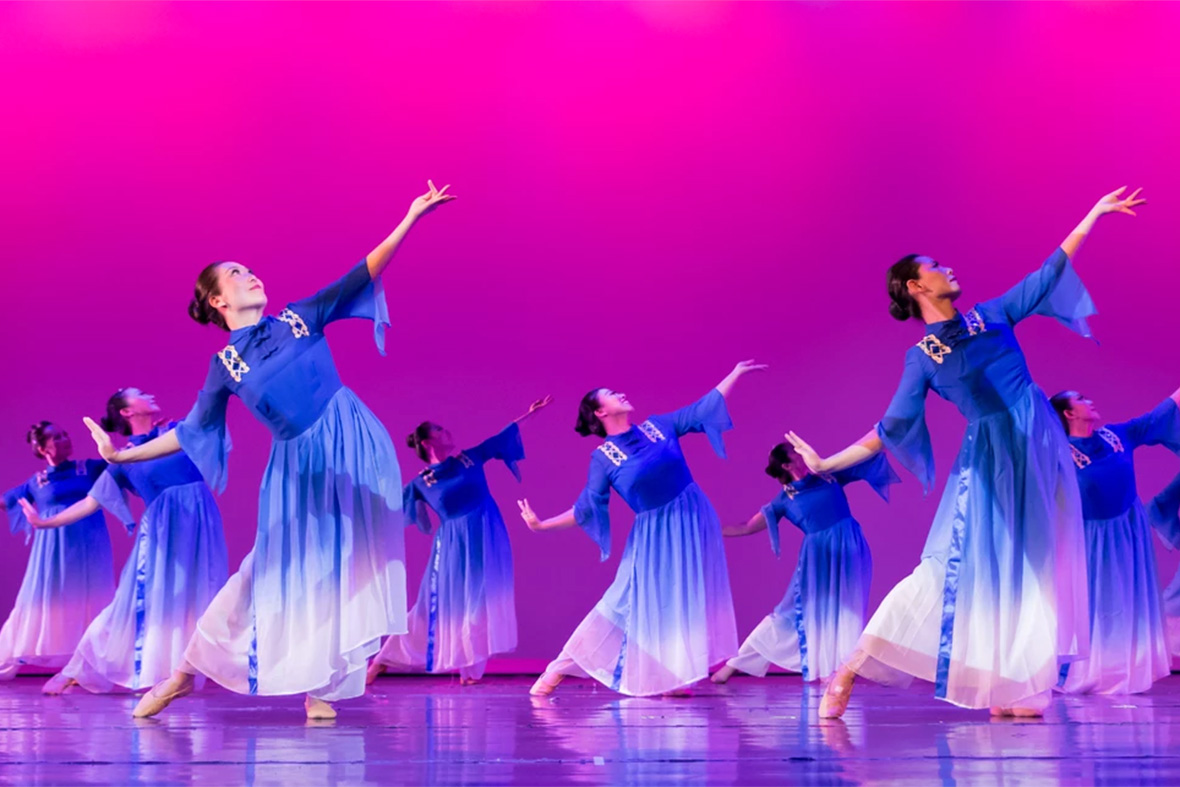
Ultimately, the difference between Chinese dance and Western dance is not explicit in Wang’s point of view. “I don’t believe there is a huge gap between the Western and Chinese dance,” says Wang. “Art is uniform in the entire universe. The difference lies only in the cultures.”
Moving forward, ADA wants to expand its students’ demographics and have a larger presence globally.
“There are more internationally known dance contests that invite Chinese dancers to participate lately,” Wang says. “Every year, our students and dance group were invited to Ivy League universities’ art festivals and popular contests like Star Dance Alliance, Kids Artistic Revue, and Elite Dance Challenge.”
Wang believes that Chinese dance’s virtuosic techniques and history are very rare in the industry. It’s an art that asks dancers to not only perform but to reflect on the past and present.
“Chinese dance is backed up by its enriched history and colorful culture, so it will never be washed away,” says Wang as she firmly puts on her patched dancing shoe, yellowed with age.
在王萌看来,中国舞和西方舞蹈并非截然不同。她说:“我不认为西方舞蹈和中国舞之间存在很大的差距。艺术在整个宇宙中是互通的,不同的只有文化的轮廓。”
她相信,ADA 能吸引更多不同群体的学生,让中国舞在世界范围内带来更大的影响力。她说:“最近,越来越多国际上知名的舞蹈比赛邀请中国舞舞者参赛。每年,我们的学生和舞蹈团队都会获邀参加常春藤大学艺术节和一些热门比赛的机会,如 Star Dance Alliance、Kids Artistic Revue、Elite Dance Challenge 等等。”
她认为,中国舞艺术技巧和其悠久的历史背景在世界舞蹈界中都十分罕见。这种艺术在要求舞者表演的同时,还要在舞蹈中反思过去和现在。“中国舞拥有深厚和多元的历史文化,其永远也不会被时代淘汰。”王萌一边说着,一边绑紧了她那双穿了多年、缝缝补补的泛黄色舞鞋。
Like our stories? Follow us on Facebook and Instagram.
Website: www.adanceacademy.net
Contributor: Wang Xintian
Chinese Translation: Olivia Li
Images Courtesy of Sam Song & Wang Meng


